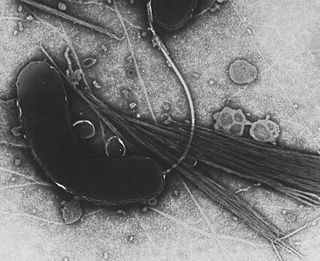
Gammaproteobacteria is a class of bacteria in the phylum Pseudomonadota. It contains about 250 genera, which makes it the most genera-rich taxon of the Prokaryotes. Several medically, ecologically, and scientifically important groups of bacteria belong to this class. It is composed by all Gram-negative microbes and is the most phylogenetically and physiologically diverse class of Proteobacteria.
Shewanella gelidimarina is a species of bacteria, notable for being an Antarctic species with the ability to produce eicosapentaenoic acid. It grows anaerobically by dissimilatory Fe (III) reduction. Its cells are motile and rod shaped. ACAM 456 is its type strain.
Shewanella frigidimarina is a species of bacteria, notable for being an Antarctic species with the ability to produce eicosapentaenoic acid. It grows anaerobically by dissimilatory Fe (III) reduction. Its cells are motile and rod shaped. ACAM 591 is its type strain.
Shewanella livingstonensis is a species of bacteria. Its cells are psychrophilic, gram-negative, rod-shaped, facultatively anaerobic and motile by means of a single polar flagellum. Its type strain is LMG 19866T.
Psychroflexus torquis is a species of bacterium. It is psychrophilic and its type strain is strain ACAM 623T. It has the ability to synthesize the polyunsaturated fatty acids eicosapentaenoic acid and arachidonic acid.
Desulfofrigus oceanense is a bacterium. It is a psychrophilic Gram-negative and sulfate-reducing bacteria with type strain Asv26T.
Desulfofrigus fragile is a bacterium. It is a psychrophilic Gram-negative and sulfate-reducing bacteria with type strain Lsv21T.
Psychroserpens burtonensis is a species of psychrophilic, yellow-pigmented bacteria. It is non-motile and nutritionally fastidious. Its type strain is ACAM 188.
Gelidibacter algens is a species of psychrophilic, yellow-pigmented bacteria. It is saccharolytic, exhibits rapid gliding motility, and its cells are rod-like to filamentous. Its type strain is ACAM 536.
Psychrobacter is a genus of Gram-negative, osmotolerant, oxidase-positive, psychrophilic or psychrotolerant, aerobic bacteria which belong to the family Moraxellaceae and the class Gammaproteobacteria. The shape is typically cocci or coccobacilli. Some of those bacteria were isolated from humans and can cause humans infections such as endocarditis and peritonitis. This genus of bacteria is able to grow at temperatures between −10 and 42 °C. Rudi Rossau found through DNA-rRNA hybridization analysis that Psychrobacter belongs to the Moraxellaceae. The first species was described by Juni and Heym. Psychrobacter occur in wide range of moist, cold saline habitats, but they also occur in warm and slightly saline habitats.
Acetobacter pomorum is a bacterium first isolated from industrial vinegar fermentations. Its type strain is LTH 2458T.
Glaciecola punicea is a psychrophilic bacteria found in Antarctic sea-ice habitats, being the type species of its genus. It is pigmented, psychrophilic, and a strictly aerobic chemoheterotroph. Its type strain is. Its genome has been sequenced.
Glaciecola pallidula is a psychrophilic bacteria found in Antarctic sea-ice habitats, being the type species of its genus. It is pigmented, psychrophilic, and a strictly aerobic chemoheterotroph. Its type strain is.
Colwellia demingiae is a psychrophilic Antarctic bacterial species with the ability to synthesize docosahexaenoic acid. It is nonpigmented, curved-rod-like in shape, exhibiting facultative anaerobic growth, and possessing an absolute requirement for sea water. Its type strain is ACAM 459T. This bacteria is named after Jody Deming, a professor and researcher at University of Washington and her research mentor, Rita Colwell.
Colwellia rossensis is a psychrophilic Antarctic bacterial species with the ability to synthesize docosahexaenoic acid. It is non-pigmented, curved rod-like shaped, exhibiting facultative anaerobic growth and possessing an absolute requirement for sea water. Its type strain is ACAM 608T.
Colwellia psychrotropica is a psychrophilic Antarctic bacterial species with the ability to synthesize docosahexaenoic acid. It is nonpigmented, curved-rod-like in shape, exhibiting facultative anaerobic growth and possessing an absolute requirement for sea water. Its type strain is ACAM 179T.
Arthrobacter roseus is a species of red-pigmented psychrophilic bacteria first isolated from a cyanobacterial mat.
Cryobacterium psychrophilum is the type species of the bacterial genus Cryobacterium. It is an obligately psychrophilic, Gram-positive irregular rod-shaped actinomycete.
Psychroflexus is a psychrophilic bacteria genus from the family of Flavobacteriaceae.
Jody W. Deming is an American oceanographer. She is a professor of Oceanography and a marine microbiologist at the University of Washington (UW). Her research interests include studies of cold adapted microbes in their relation to astrobiology, biotechnology, and bioremediation. She is known for her extensive field work, being involved in over 50 nautical research expeditions. Deming is also the cofounder of the UW Astrobiology Extremophile Laboratory.
